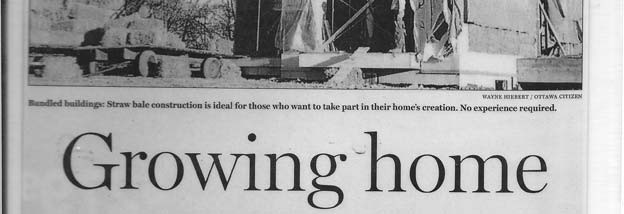Growing Home – Ottawa Citizen
By Wayne Kierbert
There is a photograph in the front of Ben Policy’s album that shows him crouched down, peering at a field of wheat. Beside it, the inscription says ‘Watching next wear’s houses grow.’
Though it may sound like something you would see in a Monty Python skit, it is accurate. Mr. Polley builds houses out of straw. If you are in doubt, his business cards confirm it: His company, founded in Guelph, is known as Harvest Homes.
Mr. Polley founded the company after learning from the masters Chris Magwood, Peter Mack ind Tina Therrien. Mr. Magwood and Mr. Mack co-authored Straw Bale Building (New Society Publishers, 256 pages, $29.95) the definitive textbook on straw bale construction for the Canadian climate.
The young entrepreneur and environmentalist and his Guelph crew built homes throughout Eastern Ontario last year. This spring,, the Kemptville. Ont_ native decided he would like to be closer to home and set up a crew in the Ottawa area.
Straw bale construction is still something of an anomaly, but it is gaining popularity. Mr. Pollev, who has an honours geography degree from Carieton University, says he hopes to do his part to bring it into the mainstream, adding that he is committed to “spreading the straw bale gospel.” To that end, he regularly holds hands-on workshops, talks and tours on straw bale building.
“I’d like to see straw bale move from being an alternative method to being a simple, everyday option,” he says.
Ottawa might be the perfect market for such a business since, as he points out, it is somewhat of a “stronghold for straw bale” already. He notes that there are a number of straw bale houses in Wakefield and Chelsea, as well as Perth.
Mr. Polley says the materials for the houses are ecologically more friendly and the homes are ultimately more energy-efficient. He also claims they are “allergy- friendly, affordable and ideal for the do-it-yourselfer.”
Depending on the design, straw bale homes do not require a lot in the way of lumber, but much in the way of straw. It is a more planet-friendly option because straw resources are considerably more renewable than hardwood. Straw can be re-harvested annually while some wood products require a tree to grow for 80 years before it is ready for harvest
Because there are so few straw bale houses, there have been few comprehensive studies about the material’s benefits.
It will take more than anecdotal evidence to convince folks such as Don Fugler, a senior researcher at the Canada Mortgage and Housing Corporation, who looks after the straw bale file.
“We’ve been doing a lot of research on these,” he says. “It’s an interesting and attractive form of housing that gets people involved. But it isn’t clear yet whether straw bale offers a big environmental benefit.”
The allergy-friendly claim, he says, is an interesting one, but he says the studies are not conclusive yet.
So what is a straw bale house? First, straw is not to be confused with hay, which is any combination of field grasses, used for livestock feed. Straw, as Straw Bale Building points out, “refers to the dried stems of grain-bearing grasses.”
Straw is used by farmers as bedding for livestock and by gardeners as mulch, but the country produces far more straw than it uses. It is mostly considered a “waste by-product of grain production
Straw that is useful for building can be extracted from wheat, oats, barley, rye and, in some climates, rice. Once the stalks are threshed and baled, they become building blocks, provided they are fashioned into square, rather than round, bales.
A straw bale building starts with a minimal wood frame. Then, the bales of hay, stacked beside and on top of each other, fit inside the framed structure. Plaster is generously applied on the inside and outside of the walls, sealing the home against “fire, rain, wind, bugs and big bad wolves,” according to the Straw Bale Building book.
Building a straw bale home demands more participation from the home buyers.
“The process is a bit more labour intensive than conventional building,” Mr. Polley says. “But the labour is less skilled, so anyone can help.”
Those interested in straw bale construction can attend a 7th Generation Community Projects workshop in September.
Mr. Polley’s company will build the feature model at the Toronto Fall Home Show, Sept. 27-30. His model will include bamboo flooring (which has a four-year harvest versus 80 years for wooden hardwood flooring) and a composite shingle made of recycled plastics, rubber and hemp.
For more information about Harvest Homes, visit the company’s Web site at www.harvesthomes.ca.

